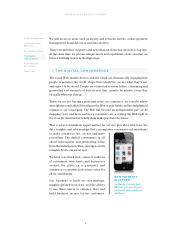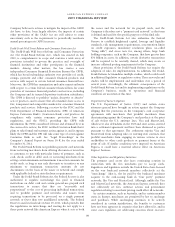American Express 2011 Annual Report Download - page 20
Download and view the complete annual report
Please find page 20 of the 2011 American Express annual report below. You can navigate through the pages in the report by either clicking on the pages listed below, or by using the keyword search tool below to find specific information within the annual report.AMERICAN EXPRESS COMPANY
2011 FINANCIAL REVIEW
When using discounted cash flow models, the Company
estimates future cash flows using the reporting unit’s internal
five-year forecast and a terminal value calculated using a growth
rate that management believes is appropriate in light of current
and expected future economic conditions. The Company then
applies a discount rate to discount these future cash flows to
arrive at a net present value, which represents the estimated fair
value of the reporting unit. The discount rate applied
approximates the Company’s expected cost of equity financing,
determined using a capital asset pricing model.
The fair value of each of the Company’s reporting units
exceeds the carrying value; accordingly, the Company has
concluded goodwill is not impaired as of December 31, 2011.
The Company could be exposed to increased risk of goodwill
impairment if future operating results or macroeconomic
conditions differ significantly from management’s current
assumptions.
INCOME TAXES
The Company is subject to the income tax laws of the United
States, its states and municipalities and those of the foreign
jurisdictions in which the Company operates. These tax laws are
complex, and the manner in which they apply to the taxpayer’s
facts is sometimes open to interpretation. In establishing a
provision for income tax expense, the Company must make
judgments about the application of inherently complex tax laws.
Unrecognized Tax Benefits
The Company establishes a liability for unrecognized tax
benefits, which are the differences between a tax position taken
or expected to be taken in a tax return and the benefit recognized
in the financial statements.
In establishing a liability for an unrecognized tax benefit,
assumptions may be made in determining whether, and the
extent to which, a tax position should be sustained. A tax
position is recognized only when it is more likely than not to be
sustained upon examination by the relevant taxing authority
based on its technical merits. The amount of tax benefit
recognized is the largest benefit that management believes is
more likely than not to be realized on ultimate settlement. As
new information becomes available, the Company evaluates its
tax positions, and adjusts its unrecognized tax benefits, as
appropriate.
Tax benefits ultimately realized can differ from amounts
previously recognized due to uncertainties, with any such
differences generally impacting the provision for income tax
expense.
Deferred Tax Asset Realization
Deferred tax assets and liabilities are determined based on the
differences between the financial statement and tax bases of
assets and liabilities using the enacted tax rates expected to be in
effect for the years in which the differences are expected to
reverse.
Since deferred taxes measure the future tax effects of items
recognized in the Consolidated Financial Statements, certain
estimates and assumptions are required to determine whether it
is more likely than not that all or some portion of the benefit of a
deferred tax asset will not be realized. In making this assessment,
management analyzes and estimates the impact of future taxable
income, reversing temporary differences and available tax
planning strategies. These assessments are performed quarterly,
taking into account any new information.
Changes in facts or circumstances can lead to changes in the
ultimate realization of deferred tax assets due to uncertainties.
18
























